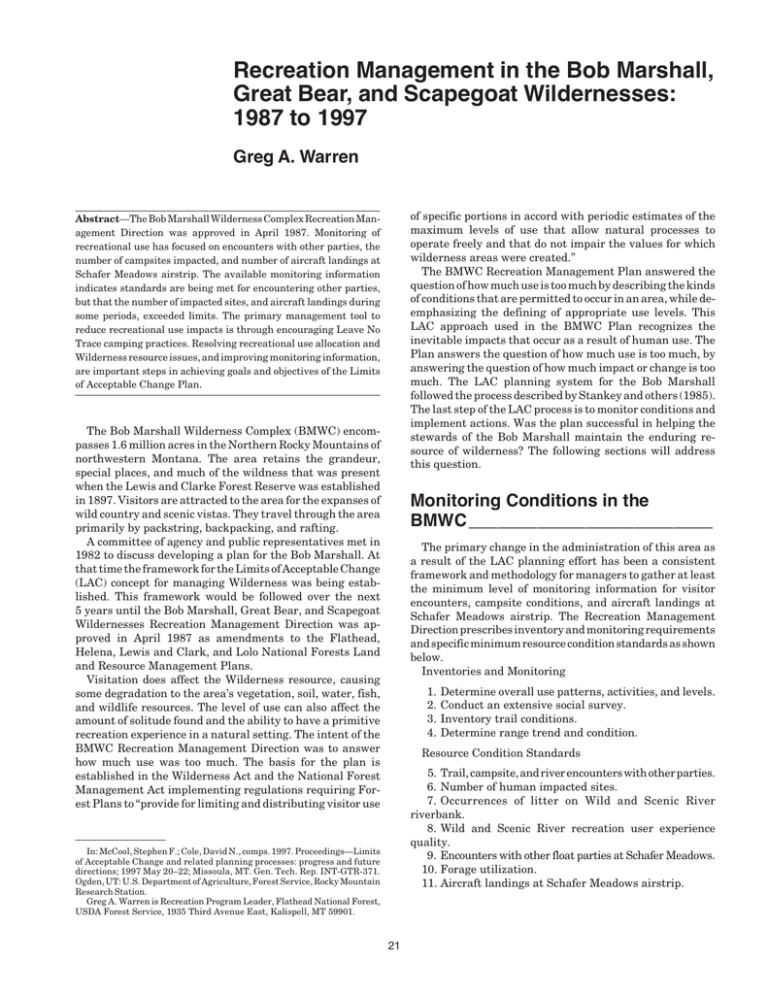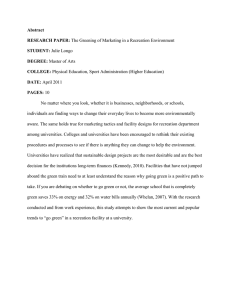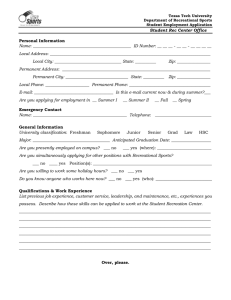Recreation Management in the Bob Marshall, Great Bear, and Scapegoat Wildernesses:
advertisement

Recreation Management in the Bob Marshall, Great Bear, and Scapegoat Wildernesses: 1987 to 1997 Greg A. Warren of specific portions in accord with periodic estimates of the maximum levels of use that allow natural processes to operate freely and that do not impair the values for which wilderness areas were created.” The BMWC Recreation Management Plan answered the question of how much use is too much by describing the kinds of conditions that are permitted to occur in an area, while deemphasizing the defining of appropriate use levels. This LAC approach used in the BMWC Plan recognizes the inevitable impacts that occur as a result of human use. The Plan answers the question of how much use is too much, by answering the question of how much impact or change is too much. The LAC planning system for the Bob Marshall followed the process described by Stankey and others (1985). The last step of the LAC process is to monitor conditions and implement actions. Was the plan successful in helping the stewards of the Bob Marshall maintain the enduring resource of wilderness? The following sections will address this question. Abstract—The Bob Marshall Wilderness Complex Recreation Management Direction was approved in April 1987. Monitoring of recreational use has focused on encounters with other parties, the number of campsites impacted, and number of aircraft landings at Schafer Meadows airstrip. The available monitoring information indicates standards are being met for encountering other parties, but that the number of impacted sites, and aircraft landings during some periods, exceeded limits. The primary management tool to reduce recreational use impacts is through encouraging Leave No Trace camping practices. Resolving recreational use allocation and Wilderness resource issues, and improving monitoring information, are important steps in achieving goals and objectives of the Limits of Acceptable Change Plan. The Bob Marshall Wilderness Complex (BMWC) encompasses 1.6 million acres in the Northern Rocky Mountains of northwestern Montana. The area retains the grandeur, special places, and much of the wildness that was present when the Lewis and Clarke Forest Reserve was established in 1897. Visitors are attracted to the area for the expanses of wild country and scenic vistas. They travel through the area primarily by packstring, backpacking, and rafting. A committee of agency and public representatives met in 1982 to discuss developing a plan for the Bob Marshall. At that time the framework for the Limits of Acceptable Change (LAC) concept for managing Wilderness was being established. This framework would be followed over the next 5 years until the Bob Marshall, Great Bear, and Scapegoat Wildernesses Recreation Management Direction was approved in April 1987 as amendments to the Flathead, Helena, Lewis and Clark, and Lolo National Forests Land and Resource Management Plans. Visitation does affect the Wilderness resource, causing some degradation to the area’s vegetation, soil, water, fish, and wildlife resources. The level of use can also affect the amount of solitude found and the ability to have a primitive recreation experience in a natural setting. The intent of the BMWC Recreation Management Direction was to answer how much use was too much. The basis for the plan is established in the Wilderness Act and the National Forest Management Act implementing regulations requiring Forest Plans to “provide for limiting and distributing visitor use Monitoring Conditions in the BMWC _________________________ The primary change in the administration of this area as a result of the LAC planning effort has been a consistent framework and methodology for managers to gather at least the minimum level of monitoring information for visitor encounters, campsite conditions, and aircraft landings at Schafer Meadows airstrip. The Recreation Management Direction prescribes inventory and monitoring requirements and specific minimum resource condition standards as shown below. Inventories and Monitoring 1. 2. 3. 4. Determine overall use patterns, activities, and levels. Conduct an extensive social survey. Inventory trail conditions. Determine range trend and condition. Resource Condition Standards 5. Trail, campsite, and river encounters with other parties. 6. Number of human impacted sites. 7. Occurrences of litter on Wild and Scenic River riverbank. 8. Wild and Scenic River recreation user experience quality. 9. Encounters with other float parties at Schafer Meadows. 10. Forage utilization. 11. Aircraft landings at Schafer Meadows airstrip. In: McCool, Stephen F.; Cole, David N., comps. 1997. Proceedings—Limits of Acceptable Change and related planning processes: progress and future directions; 1997 May 20–22; Missoula, MT. Gen. Tech. Rep. INT-GTR-371. Ogden, UT: U.S. Department of Agriculture, Forest Service, Rocky Mountain Research Station. Greg A. Warren is Recreation Program Leader, Flathead National Forest, USDA Forest Service, 1935 Third Avenue East, Kalispell, MT 59901. 21 Accomplishments and compliance with standards are summarized in table 1. The best available visitor use information indicates that the number of encounters with other parties generally met the minimum standards depicted in the management direction. The number of campsites identified exceeded minimum standards, primarily in the more heavily used Opportunity Class III and IV areas, and at destination sites such as lakes. Aircraft landings at Schafer Meadows exceeded the minimum standard for the number of landings during the Middle Fork of Flathead Wild and Scenic River float season; this predictably occurs mostly in May and June. Specific sites where resource conditions have been a known concern to managers generally had more information gathered about their condition, such as forage utilization, than the minimum requirements reported in table 1. A specific concern of managers is the limited ability to obtain monitoring data that statistically represents resource and social conditions. Much of the monitoring information collected during this period was obtained without a rigorous statistical sampling design. This limits the managers’ ability to use the monitoring samples to reach conclusions about the resource from which the samples have been drawn. As identified in table 1, this has resulted in limited or incomplete resource and social information for many of the monitoring items. Unresolved Recreation Issues and Changed Conditions _____________ Implementing Management Actions in the BMWC ___________________ During the 10 years of implementing the Recreation Management Direction, managers have continued to meet with the LAC work group to display monitoring results, identify issues that need resolution, and gain a common understanding of possible management actions needed to maintain the desired conditions described in the Plan. The BMWC managers are currently assimilating the best available resource and social information to address the level of “outfitter service levels” appropriate for providing for recreational use. This project has developed into an effort to allocate recreational use between the general public and those using the services of various types of outfitting and guiding concessionaires. Visitor use was estimated at 207,000 recreation visitordays in 1986 (one recreation visitor-day accounting for 12 hours of visitation). In 1982, approximately 57 percent of all visitors hiked, 36 percent horsebacked, 3 percent hiked with packstock, 3 percent rafted, and 1 percent used another method of travel. Of the visits by horseback, 36 percent were with an outfitter (Lucas 1985). Many recreation related issues identified during the development of the recreation management plan remain unresolved, including determination of the appropriate level of outfitter-provided recreational services; wildlife population goals, objectives, and standards; water quality standards; communications needs and facilities; and administrative site needs. Problems recognized after the plan was approved, requiring immediate action, included the spread of noxious weeds and the increased importance of securing human foods from grizzly bears. Educational programs and restrictive special orders have been successfully implemented to reduce the severity of these threats to the Wilderness and visitors. Allowing lightning caused fires to play, as nearly as possible, their natural ecological role in the Wilderness continues to be a priority in the BMWC. The prescribed natural fire program has affected recreational use by changing use patterns and possibly the amount of visitation in some years. Resolving Issues—An Ongoing Case Study _____________________ The Recreation Management Direction developed through the LAC process provided a list of management actions that could be implemented to: (1) reduce human impacted site density, (2) reduce unacceptable site conditions or impacts, (3) improve range conditions, and (4) reduce the number of aircraft landings at Schafer Meadows airstrip. Wilderness Leave No Trace education programs have been the primary action taken to address issues related to recreational use effects. Another management action being implemented in the Bob Marshall to reduce recreationist site density impacts is campsite restoration through naturalizing sites by removing campfire rings, replacing soil, and revegetating areas as needed. The principal management action taken to minimize unacceptable site impacts was to adopt special orders prohibiting livestock from being tied and grazed within 200 feet of lake shores. Table 1—Monitoring accomplishments and compliance with standards. Accomplishment Monitoring accomplished as planned Incomplete information Resource standards: mostly attained Resource standards: partially attained Resource standards: not attained a 1 2 3 X X X Monitoring and condition standarda 4 5 6 7 8 9 X X X X 11 X X X 10 X X X X X Refer to text for descriptions of the 11 monitoring requirements and resource condition standards. 22 Managers estimate that there were 191,000 recreation visitor-days of use in the Bob Marshall Wilderness Complex in 1996. Outfitters were allocated 30,000 service-days through the Recreation Management Direction. Of these 30,000 service-days, an average of 18,200 service-days have actually been used over the 3 years, 1994-1996. This level of service-days is equivalent to approximately 33,300 recreation visitor-days. Of the outfitter actual use, 56 percent was associated with fall hunting operations, 44 percent with summer roving pack and float trips, and less than 1 percent with backpacking and nonstock use. A review of the available monitoring data has revealed that evidence of human use is increasing in some specific areas. Many areas have campsites with standards that are exceeded, and management actions are needed to correct the situation. At the same time, the outfitting industry in the Bob Marshall has requested that managers review the 1980 moratorium on expanding and offering new outfitting and guiding use and services. The recreation use allocation project attempts to resolve resource impact concerns, while addressing the desire to facilitate recreational use by the general and outfitted public. A close look at the monitoring information for the BMWC as a whole, as well as for specific sites, identifies specific areas of excessive human use. Areas of concern are primarily those within 1 day travel from a trailhead, at destination areas such as the Chinese Wall, at lakes, or along rivers. Evidence of excessive use includes the number and condition of campsites, and site-specific vegetation conditions. Another concern that was not specifically addressed in the Recreation Management Direction is the condition of the trail system. The concern raised by the public and Wilderness managers is that the total number of useable trails is slowly declining, due to lack of maintenance and impact of stock use during wet periods. Managers anticipate that the trail system is not sustainable with the current level of maintenance. 7. Some additional fall outfitting base camp locations need to be available if a prescribed natural fire or wildfire requires a camp to be moved for safety reasons. Proposed Management Actions____ Based on the issues and management concerns identified, the following management actions are proposed. These actions are intended to move the Wilderness closer to desired Wilderness conditions and to promote compliance with the Recreation Management Direction minimum condition standards. Considerations for Wilderness Conditions 1. Retain the indicators and standards for Wilderness conditions described in the Recreation Management Direction. 2. Establish new LAC indicators and standards for winter use. Considerations for Recreation Management 1. Install temporary stock hitchrails or highlines for the general public at selected bottleneck locations. 2. Limit group size to the current level of 15 people, and reduce livestock numbers from the current 35 animals per group. 3. Require firepans or fire blankets for all open fires. 4. Restrict pack and saddle stock grazing before September in areas of known excessive forage use. 5. Limit livestock use to current levels for outfitters, and possibly for all recreational-use activities, unless it is projected that additional use will not degrade trail, site, and vegetation conditions. 6. Eliminate some outfitter fall hunting base camps in congested and easily accessible areas. 7. Inventory outfitter developed access trails and evaluate their effects on Wilderness conditions. 8. Issue institutional outfitter permits on a limited basis if it is determined that the use would not degrade trail, site, and vegetation conditions. 9. Continue to emphasize Leave No Trace Wilderness education programs. Concerns Identified in the Allocation Project _______________ The public was involved in the recreational use allocation project through 15 separate meetings. The purpose of the meetings was to establish a common understanding of the management situation in the BMWC, solicit information and opinions, and identify possible solutions. The following issues and concerns were used to build the actions included in the proposed action: Alternatives will be developed through additional public involvement based on variations of the above actions that reflect the Recreation Management Direction as well as allocation issues and concerns. An Environmental Assessment will be completed that discloses the impacts of the proposed action and alternatives, and the public will continue to be involved until the BMWC managers decide on the best course of action to implement. 1. Specific areas exist in the BMWC where Wilderness conditions do not meet LAC minimum standards. 2. Only the minimum necessary regulations should be used to manage the Wilderness. 3. The outfitting and guiding industry should have more flexibility in providing for recreational use opportunities. 4. Historical patterns and methods of outfitter and guide use should be maintained. 5. Areas within 1 day travel from popular trailheads need to be managed to reduce crowding and resource problems. 6. Increase the number of campsites suitable for a 14 day stay with pack and saddle stock that are not occupied by an outfitter fall base camp. Conclusions ____________________ The Recreation Management Direction for the BMWC provided the basic framework and public involvement approach to guide the management of the BMWC stewardship programs. The emphasis on describing the kinds of conditions that are permitted to occur in the area, while avoiding rigid regulatory use limits, are fundamental strengths of the LAC planning process. 23 References _____________________ The Recreation Management Direction recognized the need for improved inventories and monitoring. A sound monitoring program is an essential component of the LAC process allowing managers to implement adaptive management actions to assure that Wilderness conditions are preserved. A lack of basic inventory and monitoring information for many resource elements may hamper the ability of managers to make decisions based on actual resource conditions, and could result in a failure to resolve critical resource problems. The ongoing recreation use allocation project is a significant test as to whether the BMWC LAC Plan has made and will make a difference. Lucas, Robert C. 1985. Visitor characteristics, attitudes, and use patterns in the Bob Marshall Wilderness Complex, 1970-82. Res. Pap. INT-345. Ogden, UT: U.S. Department of Agriculture, Forest Service, Intermountain Forest and Range Experiment Station. 32 p. Stankey, George H.; Cole, David N.; Lucas, Robert C.; Petersen, Margaret E.; Frissell, Sidney S. 1985. The limits of Acceptable Change (LAC) system for wilderness planning. Gen. Tech. Rep. INT-176. Ogden, UT: U.S. Department of Agriculture, Forest Service, Intermountain Forest and Range Experiment Station. 37 p. 24






